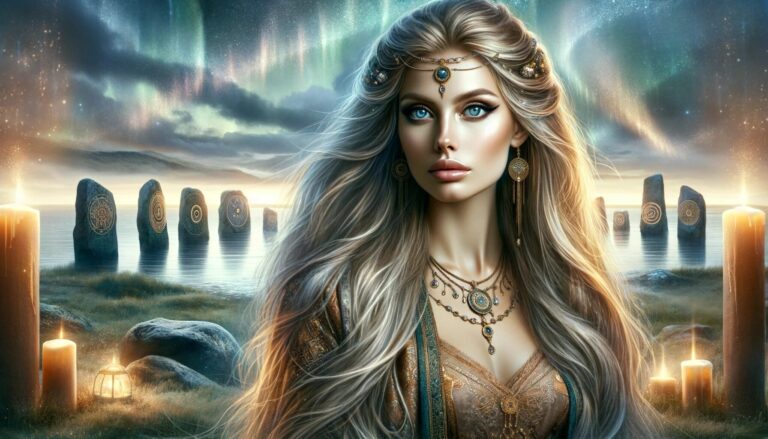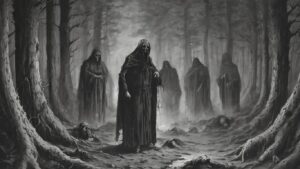Table of Contents
The Enigmatic Figure of Norse Mythology
In the rich tapestry of Norse mythology, the enigmatic figure of Hnoss shines as a captivating presence. Hnoss, whose name translates to “treasure” or “jewel” in Old Norse, is one of the beloved daughters of the goddess Freyja and the god Óðr. While her character may not be as well-documented or widely known as some of the major deities in Norse mythology, the essence of her name and her significance in the cultural context are worth exploring.
Hnoss’s Name and Symbolism

The Old Norse name “Hnoss” carries a semantic weight that resonates with notions of preciousness and value. It is a name that suggests something cherished, akin to the Icelandic term “hnoss,” which means “nipper.” Additionally, it finds a linguistic parallel in the Old Danish words “noss” (“sweetheart”) and “nusse” (“infant”), further emphasizing its endearing connotations.
In the Prose Edda, penned by the renowned Icelandic historian and writer Snorri Sturluson, we find a valuable clue about the origin of Hnoss’s name. Snorri explains that beautiful objects or treasures were referred to as “hnossir” in Old Norse, drawing a direct connection to Hnoss herself. This association reinforces the idea that Hnoss personified the concept of beauty and preciousness in Norse mythology.
While there may be limited textual information about Hnoss’s specific role or adventures in the mythological narratives, her name and its semantic ties illuminate the Norse worldview. She personifies the notion that beauty and value can be embodied by individuals, especially the offspring of powerful deities like Freyja and Óðr.
Family

Hnoss, the embodiment of beauty and treasure in Norse mythology, finds her place within a remarkable familial lineage. She is the cherished daughter of Freyja, the goddess of love, fertility, and beauty. Freyja’s allure and captivating presence in the pantheon of Norse deities make her a fitting mother for a figure associated with beauty like Hnoss.
Freyja’s spouse is Óðr, a mysterious and elusive deity often associated with inspiration and frenzy. Óðr’s connection to Hnoss’s birth adds an air of enigma to their family tree.
Hnoss is also the sister of Gersemi, another lesser-known figure in Norse mythology. Gersemi, whose name means “treasure” as well, shares her sister’s association with valuable and beautiful things, further emphasizing the importance of beauty and preciousness in their family.
In this divine family unit, Freyja’s love and beauty, Óðr’s inspiration, Hnoss’s radiance, and Gersemi’s treasure intertwine, creating a multifaceted tapestry of qualities and attributes. Together, they form a unique constellation of deities, each contributing to the richness of Norse mythology in their own distinct way.
Appearance
In Norse mythology, there are no specific physical descriptions of Hnoss. The mythology tends to focus more on the deeds and attributes of gods and goddesses rather than their physical appearances. As a result, there are no detailed accounts of Hnoss’s physical appearance provided in the surviving mythological texts.
Hnoss’s significance lies more in her association with beauty, treasure, and preciousness, which are qualities and concepts that transcend physical appearances. She is often considered a symbolic embodiment of these attributes rather than a character with a detailed physical description. Therefore, Hnoss’s appearance remains a mystery in Norse mythology, leaving room for interpretation and imagination.
FAQ
What is Hnoss's significance?
Hnoss symbolizes beauty and preciousness in Norse mythology. She represents the idea that these qualities can be embodied by individuals, reflecting the Norse worldview.
Are there any detailed physical descriptions of Hnoss?
No, there are no specific physical descriptions of Hnoss provided in Norse mythology. The focus is on her symbolic role rather than her appearance.
What linguistic connections does Hnoss's name have?
Hnoss's name is related to words like "nipper" in Icelandic and "sweetheart" and "infant" in Old Danish, emphasizing the concept of cherished and beloved treasures.
How is Hnoss mentioned in the Prose Edda?
In the Prose Edda, Snorri Sturluson explains that beautiful objects or treasures were referred to as "hnossir" in Old Norse, drawing a direct connection between Hnoss and the concept of beauty.
Does Hnoss have any siblings or family members mentioned in Norse mythology?
Hnoss has a sister named Gersemi, who is also associated with beauty and treasures. They are the daughters of Freyja and Óðr.




